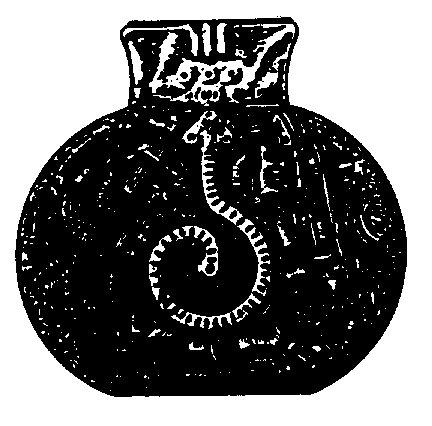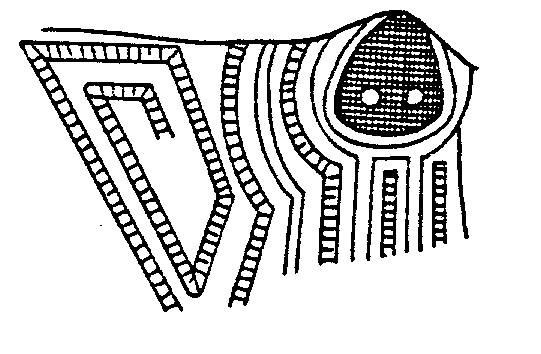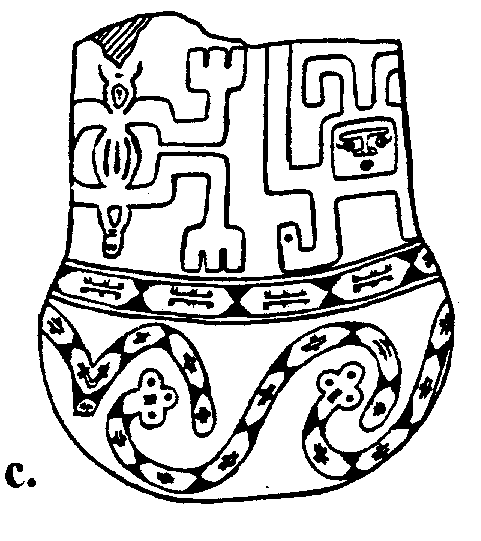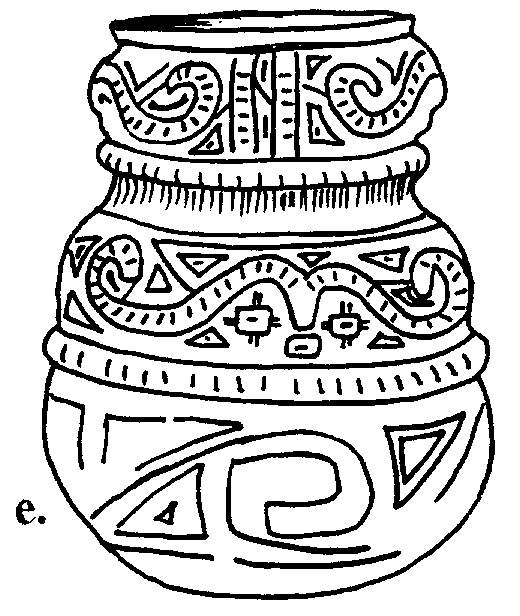 Noticias de Antropologia y Arqueología
Noticias de Antropologia y Arqueología
Marajoara Iconography: a Structural Approach |
"The recognition of the object’s structure
in art brings us an aesthetic emotion".
(Translated from Lévi Strauss, in Chabornnier, 1971:109)
This paper supports a structural methodology to understand archaeological art, since a specific case: the policromic pottery of Marajoara Phase, Marajó Island, mouth of the Amazon, Brazil. The author states that the painted, incised and excised designs are a visual and iconographic code in a lingüistic system, with a singular grammar that might be studied as such.
Este artículo defende el uso del método estructural en el estudio de la arte arqueológica, desde un caso específico: la ceramica policromica de la Fase Marajoara, Isla de Marajó, en la foz del Amazonas, Brasil. La autora sustiene que los diseños formados por las pinturas, incisiones e excisiones en la alfarrería se constituen en un código visual y iconográfico que hace parte de un sistema lingüístico, con una gramática que debe ser estudiada como tal.
_________________________________________________________________________
Since the nineteenth century, most of the researchers who described the Marajoara culture have sometimes ventured into the thorny field of iconographic studies. (Netto, 1885; Torres, 1940; Bardi, 1980; Roosevelt, 1991). The fragile analysis characterizing most of this literature is related to the lack of an adequate theoretical-methodological basis, specifically directed to the object under investigation, rather than to a naïve point of view about the archaeological art. The formal analyses methods, though extremely adequate to identify styles in order to establish comparisons and construct typologies (Palmatary, 1949; Meggers and Evans, 1957), are totally ineffective for the study of semantic representations. In turn, the identification of naturalistic shapes, whether anthropomorphic or zoomorphic, has been disseminated in an almost inconseqüent way (Roosevelt, 1991), while the appreciation of geometric designs has not received the attention it deserves. In exploring the existing bibliography, we have not found any research work that had started from a consistent sample of Marajoara pottery and had analysed the decorative motifs in a systematic way.
The ethnographic analogy has been widely and unduly used to suggest meanings for the archaeological art. Fortunately, not only have ethnologists discarded this possibility, but also a number of archaeologists restate the purely illustrative nature of the comparative method in iconographic studies (Chollot-Varagnac, 1980; Prous, 1922). It is not a contradiction to point out that the study of the features and sense assumed by artistic exhibits in contemporary indigenous societies is extremely valuable for understanding pre-historic art. Anthropological investigations have demonstrated, with no exception, that art in illiterate societies is a powerful way to communicate social, ethic and ethnic values, thus forming a code which is socially accepted and understood. The ornamentation, as closely connected to its social purpose, transmits the mythology and cosmology of a group not only to record culture but also to make it public and stable (Illius, 1988; Costa, 1987; Costa e Beltrão, 1974; Dorta, 1987 and 1981; Müller, 1990, 1992; Ribeiro, 1987, 1992; Seeger, 1987; Lopes da Silva, 1994; Lopes da Silva and Farias, 1992; Velthem, 1992, 1994; Vidal and Lopes da Silva, 1995). Therefore, art functions as a code inherent in culture and this is the ground for studying it from its intrinsic properties. Ethnographic studies, then, provide us with the theoretical basis on which to study indigenous design as a linguistic visual system that possesses coherence and organic structure.
If we assume that in the origin of art there is a concern with the transmission of cosmological concepts related to a particular mythical repertory, then we have to admit that any graphic expression displays an organization similar to the thought that has generated it. Lévi-Strauss has repeatedly demonstrated that the mythical story is not a linear one and is only apparently devoid of logic. The identification of mythemas, units of signification that conduct the narrative, has brought many insights into the universal and logical features of myths. The visual representation of myth as it happens in art is intended to depict these structures and reinforce the oral story. Even though not all representations, in view of their diverse holders, have a mythological referent - as they may simply be lineage or status signs - there is no reason to assume they are organized in a different way, since they bear ideas which were produced under the same mental process. In this context, art is revealed as a visual code that displays a global epistemological structure.
In studying Marajoara art, our concern was, at first, to elect a satisfactory number of pottery artefacts that should be carefully analysed in order to obtain the greatest amount of information available. Such sample should be looked and touched so that the subtleties and texture of the design and relief could be observed - reason why photographed or drawn pictures from other books were promptly discarded. All these conditions and the geographical proximity led us to Tom Wildi Collection, as suggested by our supervisor José Brochado, which was kindly made available to us by Professor Teresa Fossari, director of the University Museum of the Federal University of Santa Catarina at that time. We have worked with 208 wares of the Marajoara Phase, including intact and fragmented pieces, derived from at least six sites: Guajará, Laranjeiras, Gentil, Macacão, Matinada and Pacoval do Arari. In spite of the lack of a contextual record, the material is very representative of the series of techniques and decorative motifs used in Marajoara art.
For methodological reasons and considering that one of the purposes of our research was to demonstrate the potentialities of museum collection studies, no pieces other than those belonging to the collection were used, even when this could corroborate our assertions. We shall try to show here the methodology employed and the results obtained.
First the bowl profiles were drawn and the main characteristics of the objects were recorded in a data matrix according to a wide list of attributes. The vessels or fragments that showed a significant ornamentation were drawn in their entirety, keeping the proportions of the original. The analysis of the representations took place later on by using the drawings, which permitted the assessment of the group as a whole. At first, we tried to identify in the fauna of Marajó - which would not be significantly distinct from the one that existed in the pre-historic period (Marcos di Bernardo, personal communication) - those animals species represented on pottery. This search proved to be a fruitful one. A great number of real specimens corresponding to the zoomorphic representations were found in the archaeological sites. One of the representations of snakes found in the Marajoara art could be recognized as a Bothrops marajoensis or B. atrox, popularly known as "jararaca", which displays a unique feature: its head is shaped like a spearhead (Hoge, 1966; Ávila-Pires, 1990). On a vessel drawn by Tom Wildi (fig. a) it is easily recognized, and on a fragment of a bowl (fig. b) we can observe its representation in a stylized form.
|
a. |
b. |
The internal hachured zone that appears in both pictures could well represent the snake’s ventral side, as suggested by biologist Marcos di Bernardo. Almost all snake species display this design formed by the sequence of light-colored scales. Another snake representation that appears in the collection in a more naturalistic form displays a head formed by three semispheres - which also suggests a spearhead shape - and a body covered by alternate signs. We have verified that the snake’s body movements represented on the funerary urn presented below (fig. c) are very much similar to those appearing in a stylized form, surrounded by triangles, on a bowl fragment (fig. d). If there is any doubt as to the fact that the sinuous lines depict snakes, the next picture (fig. e) shows clearly the relationship between snakes and triangles.
The two examples above show the basis of our method, that is, the search for structural similarities between the representations, considering structure as
"a pattern built according to certain simplificative operations that allow me to uniform different phenomena as from a single point of view" (Translated from Umberto Eco, 1976:36).
Though our methodology implies working with a sense of stylization in comparing zoomorphic designs and graphic signs, it does not follow that we see naturalistic representations as previous to graphs in a diachronic sequence. Apart from the fact that the material is not archaeologically dated, the geometrical design may represent the structure, rather than the form, of the real object, a matter which depends solely on agreement between the "interlocutors" of this form of visual communication. According to Leroi-Gourhan (1985), the Upper Paleolithic art emerged representing rhythms and ideas rather than naturalistic forms, which were developed later.
The example above (fig. d) shows that there is an iconic representation of the snake, since it is related to its referent by lines defining its basic shape; in this case, there is a parallel between shape and structure. The identification of this iconicity emerged as a consequence of the context, without which the representation could only be interpreted as "interlaced sinuous lines". Thus, in a similar way, we have identified a number of iconic signs by comparing more "naturalistic" representations and graphs. Of course, this could not have been done without a sound theoretical basis, sought for in the works by Nancy Munn (1962, 1966, 1973) among the Australian Walbiri. This ethnologist, whose ideas have largely influenced a number of Brazilian anthropologists studying indigenous art in Brazil (Ribeiro, 1987a, 1987b; Langdon, 1992; Müller, 1982; Vidal e Silva, 1992), has identified in the guruwari (drawings made by the Walbiri in sand and stone) the existence of a visual iconic language widely used by social groups and related to the history of their mythical ancestors. The graphs, unintelligible to any foreigner, were used as a support to the verbal narrative, lending visual strength to it. From a certain number of iconic graphic signs, so defined according to their structural relationship with their referents, the Walbiri elaborated designs of varying complexity and semantic content. As each of these signs, called by Munn as minimal meaningful unit, could have more than one single referent, the determination of its meaning depended on its relative position in the context and its relationship with the other elements.
Rex González (1974:13), studying the archaeological art from north-west Argentina, stated that
"attributes are rearranged to create new images whose recurrence clearly indicates the existence of a true message, in which the essencial elements would display - by analogy - the character of true phonemes of figurative phrases, which may vary in their formal or stylistic aspects, but whose relationships are preserved in such a way as to permit acknowledging the constancy or differences in structure that lend coherence to the whole" (Translated from the original).
The author also supposed that it was possible to find out a type of grammar organizing the formal relations between these essential elements. Nevertheless, to the best of our knowledge, this line of research has not been further developed.
Following similar parameters, we can acknowledge, in Marajoara art, the existence of minimal structures that might be related not only to a zoomorphic representation but also to one of its minimal parts. Rex Gonzáles (op. cit) identifies, in the above-mentioned work, the existence of naturalistic representations that could be decomposed into essential elements, like claws and eyes. The well-known representation of the scorpion on the Pacoval Incised funerary vessel is closely related to any representation of eyes in Marajoara art. This can be seen by the transformation it undergoes in several drawings, in which this idea, whose origin is a scorpion, is finally transmitted only by two short parallel dots, a minimal unit which represents an essential concept of this referent. We call these basic units as "minimal meaningful units" (Munn, Müller, op.cit.) - which implies they have a meaning, yet unknown. The pictures below show the representation of the scorpion as it appears on the vessel mentioned; we can compare it to a true scorpion and to see the way it was represented in iconical form.
The true scorpion The vessel scorpion The identified structure The minimal meaningful units
Examples of localization of units on wares from Tom Wildi Collection
The assumption that parts of the object represented still contain the same strength of meaning is also supported by observations made by Regina Polo Müller (1990, 1992) among the Asurini do Xingu, Brazil, in which minimal meaningful units were identified as well in decorative motifs. According to Indian reports, the dummy Tayngava (human imagery) could be equally represented by a part of its body only, and, whatever part was represented, Tayngava was promptly recognized by people. We think that certain concepts in Marajoara art could be equally represented by two slightly different units, as can be seen by the relative position they occupy in the drawings. Studying the design of Kayabí basketry, Berta Ribeiro (1987b) considers that variations in shape displayed by some signs may be semantic or vocabulary variations.
The representation of the lizard, or crocodile, often seen in large excised vessels, has also been linked to a minimal meaningful unit, namely a "trident", which appears in almost all designs, frequently occupying a central position related to the head:
The naturalistic representation The stylized representation The structure The unit
Based on iconic graphic signs identified from the structural comparison with natural referents, and by comparing the different drawings among themselves, we could identify 52 minimal meaningful units in Marajoara art. No meaning was imputed to these units at any moment of our research. Comparisons with animals were made only to identify them and show the relation between an intelligible concept and the referent. As the present research was restricted to Tom Wildi Collection, it is important to state that these units are just a hypothesis that should be tested in a larger sample, when it will certainly be modified.
By employing a structural theoretical and methodological approach, and based on the great achievements of Munn, Ribeiro, Velthem and Müller (op. cit.), we intend to continue our research extending it to a larger sample of Marajoara art. Even though Marajoara graphs cannot be seen as a type of writing, we understand that it is an iconic visual language (Schaan, 1996, 1997) that has a generative and structural grammar that can be studied and understood.
References Cited
ÁVILA-PIRES et alii. Répteis da Ilha de Marajó, Pará, Brasil. Levantamento preliminar de lagartos e ofídios (squamata). Resumo de publicação. Londrina, Res. XVII, Congresso Brasileiro de Zoologia, 1990.
BARDI, P.M. Arte da cerâmica no Brasil. São Paulo, Banco Sudameris, 1980.
BROCHADO, José Proenza. The social ecology of the Marajoara Culture. M.A. Thesis, University of Illinois, Urbana, Illinois, 1980.
_________. An archaeological model of the spread of pottrery and agriculture into southeastern south america. PhD. Tesis, Univeristy of Illinois, Urbana, Illinois, 1984
_________. "Um modelo ecológico de difusão da cerâmica e da agricultura no leste da América do Sul". Clio, Série Arqueologia nº 4 (85-88). Anais do I Simpósio de Pré-história do Nordeste brasileiro. UFPE, 1991.
BROCHADO, José Proenza e LATHRAP, Donald W.Cronologies in the New World Amazonia. Unpublished paper. Cópia xerográfica, 1982.
CHARBONNIER, Georges. Arte, lenguaje, etnologia. Entrevistas com Claude Lévi-Strauss. Mexico, Argentina, Espanha, Siglo veintiuno, 1971.
CHOLLOT-VARAGNAC, Marthe. Les origenes du graphisme symbolique. Paris, éditions de la fondation Singer-Polignac, 1980.
COSTA, Maria Heloísa Fenelon. "O sobrenatural, o humano e o vegetal na iconologia Mehináku." In: RIBEIRO, Berta (org.). Suma etonológica brasileira Vol. 3. Petrópolis, Vozes, 1987.
COSTA, Maria Heloísa Fenelon e BELTRÃO, M. C. de Moares. "Documentos visuais como elementos de informação cultural." Dédalo 20 (5-10). São Paulo, USP, 1974.
DORTA, Sônia Ferraro. "Plumária Bororo". In: RIBEIRO, Berta (org.). Suma etnológica brasileira. Vol 3. Petrópolis, Vozes, 1987.
_________. "Paríko. Etnografia de um artefato plumário." Coleção Museu Paulista. Etnologia. Vol. 4. São Paulo, ed. do Fundo de Pesquisas do Museu Paulista, 1981.
ECO, Humberto. A Estrutura Ausente: introdução à pesquisa semiológica. São Paulo, perspectiva, 1976.
_________. Como se faz uma tese. São Paulo, perspectiva, 1993.
ILLIUS, Bruno. La "Gran Boa". Arte y Cosmologia de los Shipibo-Conibo. Traduzido a partir do original "Die Grosse Boa". Kunst und Kosmologie der Shipibo-Conibo. Münzel (ed.). Die mythen sehen, vol. 2 (705-728, 732-735). Frankfurt, 1988.
LANGDON, Jean. "Alucinógenos: fonte de inspiração artística. A cultura Siona e a experiência alucinógena". In: VIDAL, Lux (org.). Grafismo indígena: Estudos de antropologia estética. São Paulo, Fapesp, 1992.
LEROI-GOURHAN, André. O gesto e a palavra. 1. Técnica e Linguagem. São Paulo, Martins Fontes, 1985.
LÉVI-STRAUSS, Claude. Antropologia Estrutural 2. Rio, Tempo Brasileiro, 1975.
_________. Mito e significado. Lisboa, edições 70, 1978.
_________. A oleira ciumenta. Lisboa, edições 70, 1987.
LÉVI-STRAUSS, Claude e ERIBON, Didier. De perto e de longe. Rio, Nova Fronteira, 1990.
LOPES DA SILVA, Aracy. "Mitos e cosmologia indígenas no Brasil: breve introdução". In: GRUPIONI, Luis Donisete Benzi (org.) Índios no Brasil. Brasília, Min. da Educação e do Desporto, 1994.
LOPES DA SILVA, Aracy e FARIAS, Agenor T.P. Pintura corporal e sociedade: os "partidos"xerente. In: VIDAL, Lux org.). Grafismo indígena: Estudos de Antropologia estética. São Paulo, Fapesp, 1992.
MEGGERS, Betty J. The Beal-Steere collection of pottery from Marajó Island, Brazil. Reprinted from papers of the Michigan Academy of Science, Arts and Letters, Vol. XXXI, 1947.
__________. The theory and purpose of cermic analysis. Proceedings of the 2nd international congress foi the study of Pre-Columbian Cultures in the Lesser Antilles. Barbados, 1967.
__________. Amazônia, a ilusão de um paraíso. Rio, Civilização Brasileira, 1971.
MEGGERS, Betty & EVANS, Clifford . Archaeological investigations at the mouth of the Amazon. Washington, Government Printing Office, 1957.
___________.Como interpretar a linguagem da cerâmica: manual para arqueólogos. Washington, Smithsonian Institution, 1970
MÜLLER, Regina Polo. Os asuriní do Xingu. História e Arte. Campinas, ed. da Unicamp, 1990.
__________. "Mensagens visuais na ornamentação corporal Xavante." In: VIDAL, Lux (org.).Grafismo indígena: Estudos de antropologia estética. São Paulo, Fapesp, 1992.
MUNN, Nancy D. "Walbiri graphic signs: an analysis."American Anthropologist, 64 (972-984), 1962.
________. "Visual categories: an approach to the study of representational systems." American Anthropologist, 68 (936-950), 1966.
________. "The spatial presentation of cosmic order in Walbiri Iconography". Primitive art and society. Forge, Anthony (ed.). London, Oxford University, 4 (193-220), 1973.
NETTO, "Investigações sobre a arqueologia brasileira". Arquivos do Museu Nacional. 6:257-554., 1885.
NORDENSKIÖLD, Erland. L’Archéologie du Bassin de L’Amazone. Paris, Les Éditions G. Van Oest, 1930.
PALMATARY, Helen. "The pottery of Marajó Island." Transactions of the American Philosophical Society held at Philadelphia for promoting useful knowledge. N.S. XXXIX, 3, 1949.
PROUS, André. Arqueologia brasileira. Brasília, UNB, 1992.
REX GONZÁLEZ, Alberto. Arte, estructura y arqueología. Análisis de figuras duales y anatrópicas del N.O. argentino. Buenos Aires, Nueva Visión, 1974.
RIBEIRO, Berta G. A arte do trançado dos índios do Brasil. Um estudo taxonômico. Belém, Museu Paraense Emílio Goeldi. Rio, Inst. Nacional do Folclore, 1985.
___________. "A linguagem simbólica da cultura material. Introdução." In: RIBEIRO, Berta. (org.). Suma Etnológica brasileira vol. 3. Petrópolis, Vozes/Finep, 1987a.
___________. "Desenhos semânticos e identidade étnica: o caso Kayabí". In: RIBEIRO,Berta (org.). Suma etnológica brasileira Vol 3. Petrópolis, Vozes/Finep, 1987b.
___________.Dicionário do Artesanato Indígena. São Paulo, Edusp, 1988.
___________."Mitologia: verdades fundamentais e expressão gráfica. A mitologia pictórica dos Desâna". In: VIDAL, Lux (org.) Grafismo indígena: Estudos de Antropologia estética. São Paulo, Fapesp, 1992.
RIBEIRO, Berta G. e VELTHEM, Lúcia H. van. "Coleções etnográficas - Documentos materiais para a história indígena e a etnologia". In CUNHA, Manuela Carneiro da (org.). História dos índios no Brasil. São Paulo, Cia das Letras, Fapergs/SMC, 1992.
ROOSEVELT, Anna Curtenius. Chiefdoms in the Amazon and Orinoco. In: DRENNAN & URIBE (eds.). Chiefdoms in the Americas. Boston, University Press of America, 1987.
___________."Forest civilizations of the lower Amazon." Natural History, 2 (75- 82), 1989.
___________.Moundbuilders of the Amazon. Geophysical Archaeology on Marajo Island, Brazil. San Diego, California, Academic Press, 1991.
___________."Secrets of the Forest. An archaeologist Reappraises the past -and future - of Amazonia". The Sciences, nov/dez, 1992a..
___________. "As sociedades complexas indígenas na Amazônia". In: CUNHA, Manuela Carneiro da (org). História dos índios no Brasil. SãoPaulo, Cia das Letras, Fapesp/SMC, 1992b.
___________. "Sociedades pré-históricas do Amazonas Brasileiro". In: Brasil (Catálogo da exposição "Nas vésperas do mundo moderno: África e Brasil", organizada pela Comissão Nacional para as Comemorações dos Descobrimentos Portugueses). Lisboa, Quetzal editores, 1992c.
___________."Early pottery in the amazon. Twenty years of Scholarly obscurity." In: BARNETT e HOOPES (eds.). The emergence of pottery. Technology and innovation in ancient societies. Washington and London, Smithsonian Institution Press, 1995.
SCHAAN, Denise Pahl. A Linguagem Iconográfica da Cerâmica Marajoara. M.A. Dissertation, PUC/RS, 1996.
___________. A Linguagem Iconográfica da Cerâmica Marajoara - um estudo da arte pré-histórica da Ilha de Marajó, Brasil (400-1300 AD). Coleção Arqueologia, vol 3. Porto Alegre, EDIPUC/RS, 1997.
SEEGER, Anthony. "Novos horizontes na classificação dos instrumentos musicais". In: RIBEIRO, Berta (org.). Suma etnológica brasileira. Petrópolis, Vozes, 1987.
__________. Os Índios e nós. Estudos sobre sociedades tribais brasileiras. Rio, Campus, 1980.
TOCHETTO, Fernanda Bordin. Possibilidades de interpretação do conteúdo simbólico da arte gráfica guarani. Relatório final apresentado para FAPERGS, Bolsa Recém-Mestre, 1993.
TORRES, Heloisa Alberto.Arte Indígena da Amazônia. Nº 6. Publicações do Serviço do Patrimônio Histórico e Artístico Nacional. Rio, MES, Imprensa Nacional., 1940
VELTHEM, Lucia Hussak van. "Das cobras e lagartas: a iconografia Wayana". In: VIDAL, Lux (org.) Grafismo indígena: Estudos de Antropologia estética. São Paulo, Fapesp, 1992.
___________."Arte indígena: referentes sociais e cosmológicos". In: GRUPIONI, Luis Donisete Benzi (org.) Índios no Brasil. Brasília, Min. da Educação e do Desporto, 1994.
VIDAL, Lux. Grafismo indígena: Estudos de Antropologia estética. São Paulo, Fapesp, 1992.
VIDAL, Lux e LOPES DA SILVA, Aracy. O sistema de objetos nas sociedades indígenas: arte e cultura material. In: SILVA e GRUPIONI (orgs.) A temática indígena na escola. Novos subsídios para professores de 1º e 2º graus. Brasília, Mec/Mari/Unesco, 1995.
Buscar en esta seccion :







